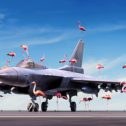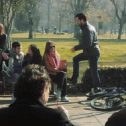"A soldier and his superior have conflicting views on the battlefield."
Until Dawn is a short film about a soldier whose conscience puts him in conflict with himself on the battlefield. It was created by four artists during their second-year studies at French school Supinfocom Rubika.
Three main characters, a strong internal conflict that triggers external conflicts, a war theme with related iconography and a script that ends with all of its main characters dead are the key components of the short.
Staged in a battlefield in a rural environment at night and at dawn, the short makes use of lighting, screen directions, VFX and props to describe the confronting armies and the bleak landscape that’s left a few hours later. A stylized aesthetic is used, with color being employed for differentiating the soldiers from the two armies, as well as for detaching them from the background and for showing passage of time. Plenty of work has been dedicated to environment design, with 3D integrated smoothly to aid and complement 2D animation. The expressiveness of the protagonist helps greatly in building and transmitting conflict.
Visual rhythm varies and is handled through editing, changes in lighting, motion within the frame, camera moves (dollies, pans, tilts and a crane shot at the end), camera shakes, etc. It increases appropriately when tension and conflict rise.
Framing employs extreme long shots and long shots to convey the location and action taking place, medium and close-ups are used to transmit emotions and conflicts of the characters, most notably of Adrien, the protagonist, whose strong internal struggle propels the story forward. Two-shots and three-shots are also present, to transmit the evolving conflict between Adrien and his superior, as well as how they interact with the soldiers from the confronting army. Sound plays a key role too in describing the battle and increasing conflict.
Three shots are worth noting, among others, the continuity break at 0m54s that helps transmit the shocked emotional state of the protagonist, the birds taking flight at 2m24s, which was used during the silent era to portray a gunshot visually, and the ending crane shot that gives a wider view of the final result of the confrontation.
What makes Until Dawn work so well? Strong internal and external conflicts, intense depiction of war, elements of surprise and a confrontation between compassion and mercilessness that will leave viewers thinking.
Clémentine Peyrusaubes's site
Elise Marlier's site
Juliette Scouvemont's site
Meï-Leen Giraud's site



















Recent Comments